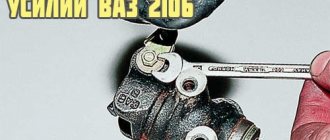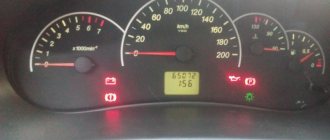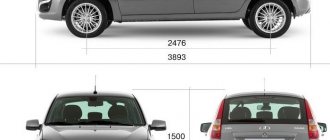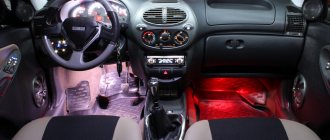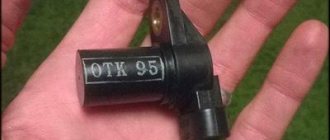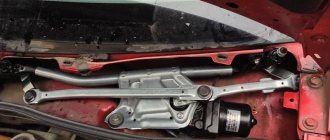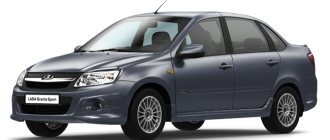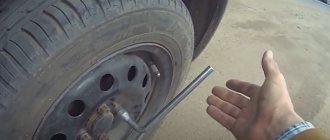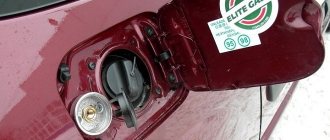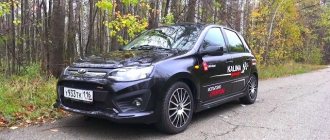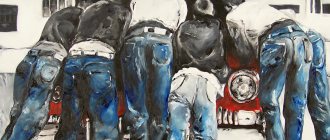Payment for goods and downloading of the book in electronic form (PDF format) is made on the website.
To do this, you need to find the book you are interested in and click on the “Buy” button. The price of the book is indicated on the button.
For convenience, the price on the website for residents of Russia, Belarus and Kazakhstan is presented in rubles.
For residents of Ukraine in hryvnias, and for all other countries - dollars.
After clicking on the “BUY” button, a payment window will open where you can select a payment system with which you can pay for the selected book using any bank card (Visa, MasterCard, MIR, etc.)
When you click on the “Pay by bank card” button, the Portmone payment system will open, which is the easiest way to make a payment.
In addition, the website offers four payment systems for payment:
- Yandex (payment from any bank cards, Yandex Money account, QIWI Wallet, terminals, etc.);
- Portmone (payment from any bank cards, Portmone account);
- PayPal (payment from any bank cards, PayPal account);
- WebMoney (payment from any bank cards, payment from WebMoney wallets).
Payment via Yandex Cashier
After selecting payment via Yandex, the Yandex Cashier payment system will launch, where you need to select a convenient payment method (bank card, QIWI, Yandex Money account, etc.)
After specifying payment details and confirming payment, payment for the goods will occur.
If you have a bank card in a currency other than the ruble, then the money will be debited from the card at the rate of the Central Bank of Russia at the time of the purchase.
This payment method is optimal for residents of Russia, Kazakhstan and Belarus.
Official website of the Yandex Kassa payment system https://kassa.yandex.ru
Tips for choosing oil and filter for Kalina
According to the factory's recommendation, the oil for filling into the Lada Kalina engine is synthetic or semi-synthetic. Among the original compositions recommended by the manufacturer, we can highlight Lada 5W-40 and RN Magnum Ultratec 5W-40 from Rosneft.
There are other recommended oils with similar characteristics from other brands:
- Mobil Super 3000 X1 5W-40.
- Shell Helix HX8 5W-40.
- Lukoil Genesis Armortech 5W-40.
To select oil according to characteristics depending on engine type, you can use the table:
| ICE/number of valves | Tolerance | Viscosity |
| 1.4 l., 89 l. With. (11194)/16 | API-SH, SJ, SL, SM | SAE 5W-40, 0W-40, 0W-30, 10W-30, 5W-30, 10W-40 |
| 1.6 l., 81 l. With. (21114)/8 | API-SH, SJ, SL, SM | SAE 5W-40, 0W-40, 0W-30, 10W-30, 5W-30, 10W-40 |
| 1.6l., 81 l. With. (11183)/8 | API-SH, SJ, SL, SM | SAE 5W-40, 0W-40, 0W-30, 10W-30, 5W-30, 10W-40 |
| 1.6 l., 82 l. With. (21114)/8 | API-SH, SJ, SL, SM | SAE 5W-40, 0W-40, 0W-30, 10W-30, 5W-30, 10W-40 |
| 1.6 l., 84 l. With. (21114)/8 | API-SH, SJ, SL, SM | SAE 5W-40, 0W-40, 0W-30, 10W-30, 5W-30, 10W-40 |
| 1.6 l., 98 l. With. (21126)/16 | API-SH, SJ, SL, SM | SAE 5W-40, 0W-40, 0W-30, 10W-30, 5W-30, 10W-40 |
| ICE/number of valves | Tolerance | Viscosity |
| 1.6 l., 106 l. With. (21127)/16 | API-SM, SN | SAE 5W-40, 0W-40, 0W-30, 10W-30, 5W-30, 10W-40 |
| 1.6 l., 82 l. With. (11183-50)/8 | API-SM, SN | SAE 5W-40, 0W-40, 0W-30, 10W-30, 5W-30, 10W-40 |
| 1.6 l., 87 l. With. (11186)/8 | API-SM, SN | SAE 5W-40, 0W-40, 0W-30, 10W-30, 5W-30, 10W-40 |
| 1.6 l., 98 l. With. (21126)/16 | API-SM, SN | SAE 5W-40, 0W-40, 0W-30, 10W-30, 5W-30, 10W-40 |
The choice of viscosity depends on the climatic conditions of the region. If the temperature in winter drops to -30°C, and in summer rises to +35°C, stop at SAE 5W-40. For cars with more than 100 thousand km, it is recommended to take a thicker composition, for example, SAE 10W-40.
What to consider when choosing oil:
- synthetic compounds have better fluidity, which reduces friction of the components;
- pour “summer” and “winter” compositions depending on the season of the year, they differ in viscosity;
- choose original oil from the manufacturer with the official approval of AvtoVAZ - Rosneft, Lukoil, Mobil, Gazpromneft;
- Be guided by the price-quality rule; it is recommended to study reviews from car enthusiasts.
The original catalog numbers of the oil filter for Lada Kalina are 21080-1012005-0 and 2108-10120050-10. During assembly, models from or “Salyut-Filter” are most often installed.
However, the quality of the paper used is low, so car owners prefer to choose a more reliable manufacturer, for example, MANN (W914/2) or Knecht/MAHLE (OC 384).
Payment via Portmone
After selecting payment through Portmone, the payment system will launch, where you need to select the payment method: bank card or Portmone account.
The price in the Portmone payment system is converted into dollars at the exchange rate of the Central Bank of the country where you are located.
If you have a bank card in a currency other than the dollar, then the money will be debited from the card at the rate of the Central Bank of your country at the time of the purchase.
After specifying payment details and confirming payment, payment for the goods will occur.
Official website of the Portmone payment system https://www.portmone.com
Oil volume in Kalina engines 1 and 2
Lada Kalina cars of the 1st generation were equipped with 4 types of power plants. The table shows the oil volume depending on the engine model.
| Type of internal combustion engine/number of valves | Oil volume, liters |
| 1.4 l, 89 hp/16 | 3,5 |
| 1.6 l, 81 hp/8 | 3,5 |
| 1.6 l, 81 hp/82 hp/84 hp/8 | 3,5 |
| 1.6 l, 98 hp/16 | 3.4 (4.4 with automatic transmission) |
These figures cannot be reduced, otherwise the likelihood of piston jamming and damage to the liners increases. The first sign of a lack of lubricating fluid is a signal on the dashboard.
The table shows the oil volumes for Lada Kalina 2 depending on the type of power plant:
| Type of internal combustion engine/number of valves | Oil volume, liters |
| 1.6 l, 106 hp/16 | 3,5 |
| 1.6 l, 82 hp/8 | 3,5 |
| 1.6 l, 87 hp/8 | 3,6 |
| 1.6 l, 98 hp/16 | 3.2 (4.4 with automatic transmission) |
The situation is also dangerous if the level is elevated above normal. Consequences: reduction in power, entry into the combustion chamber. In the next case, the converter fails. Additionally, the expansion of the liquid when heated is taken into account. Even a slight excess will lead to negative consequences.
Payment via PayPal
After selecting payment via PayPal, the PayPal payment system will launch, where you need to select the payment method: bank card or PayPal account.
If you already have a PayPal account, then you need to log into it and make a payment.
If you do not have a PayPal account and you want to pay using a bank card via PayPal, you need to click on the “Create an Account” button - shown with an arrow in the picture.
PayPal will then prompt you to select your country and provide your credit card information.
After specifying the information required to make the payment, you must click on the “Pay Now” button.
Official website of the PayPal payment system https://www.paypal.com
LADA Kalina engine cooling system diagram
diagram of the LADA Kalina cooling systemCooling system: 1 - coolant drain hose from the heater radiator; 2 — hose for supplying coolant to the heater radiator; 3 — coolant pump supply pipe hose; 4 — expansion tank hose; 5 - expansion tank; 6 — steam exhaust hose of the engine radiator; 7 — thermostat; 8 — hose for supplying fluid to the throttle assembly; 9 — hose for supplying fluid to the engine radiator; 10 hose for draining fluid from the engine radiator; 11 — engine radiator; 12 radiator drain plug; 13 electric radiator fan; 14 coolant pump; 15 supply pipe of the coolant pump; 16 coolant drain hose from the throttle body
Payment via WebMoney
After selecting payment via WebMoney, the payment system will launch, where you need to select the payment method: bank card or WebMoney wallet.
If you already have a WebMoney wallet, then you need to log into it and make a payment.
If you do not have a WebMoney wallet and you want to pay in another way, you need to select any of the methods that WebMoney offers and make the payment
After specifying payment details and confirming payment, payment for the goods will occur.
Official website of the WebMoney payment system https://www.webmoney.ru/
What does a car consist of?
Of course, the structure of a modern machine includes many different components and parts, but even among them the main ones can be identified:
- transmission,
- body,
- chassis,
- engine,
- control systems,
- electrical equipment.
Each of these elements plays an important role that is difficult to overestimate. To understand how important the correct operation of each part is, let’s look at them in more detail.
Body
The body is the supporting part of the car. It is to it that all components and assemblies are attached. Nowadays, automobile manufacturers are trying to do everything possible to select the most durable and lightest composite resin that will serve as the basis of the product.
The fact is, ordinary metal weighs quite a lot. Increasing weight negatively affects dynamics, top speed and acceleration, and driving a heavy car is very difficult. As a result, non-standard approaches to creating bodies are now increasingly being used. For example, hydrocarbon fiber is used in construction.
Downloading a book
After successfully completing the payment (by any method) and returning to the KrutilVertel store from the payment system website, you will be taken to the successful payment page:
On this page you need to indicate your e-mail, where access to download the book will be sent.
If you are already registered on our website, then simply follow the link to your personal account.
The book you purchased will be in your personal account, from where you can always download it.
Please note that after making the payment, you need to return back from the payment system website to the KrutilVertel website.
If for some reason you did not return back to the site and closed the payment system tab with a message about the successful completion of the payment, please let us know - we will send you a letter indicating access to download the book.
Design of the LADA Kalina cooling system
Cooling system: 1 — expansion tank;
2 — radiator outlet hose; 3 - inlet hose; 4 - radiator; 5 — steam exhaust hose; b — radiator supply hose; 7 — electric fan; 8 — electric fan casing; 9 — coolant temperature sensor; 10 — coolant temperature indicator sensor; 11 — throttle assembly; 12 — bracket for the coolant pump pipe; 13 — coolant pump; 14 — coolant pump pipe; 15 — heater radiator supply hose; 16 — heater radiator outlet hose; 17 — exhaust pipe; 18 — coolant pump pipe hose; 19 — thermostat housing Expansion tank. Coolant is poured into the system through the expansion tank. It is made of translucent polyethylene, which allows you to visually monitor the liquid level. To do this, the marks “MAX” and “MIN” are marked on the wall of the tank. In the upper part of the tank there is a pipe for connecting to the radiator steam exhaust hose, in the lower part there is a pipe for connecting to the inlet hose. Expansion tank viburnum
Expansion tank cap with valves. The tightness of the system is ensured by the inlet and outlet valves in the expansion tank cap. The exhaust valve maintains increased (compared to atmospheric) pressure in the system on a hot engine (due to this, the boiling point of the liquid becomes higher, steam losses are reduced}. It begins to open at a pressure of at least 1.1 bar. The intake valve opens when the pressure drops to system relative to atmospheric pressure by 0.03-0.13 bar (on a cooling engine).Expansion tank cap with valves
The coolant pump is a vane, centrifugal type, driven from the crankshaft pulley by a timing belt. The pump housing is aluminum. The roller rotates in a double-row bearing. The bearing is lubricated for its entire service life. The outer ring of the bearing is locked with a screw. A toothed pulley is pressed onto the front end of the roller, and an impeller is pressed onto the rear end. A thrust ring made of a graphite-containing composition is pressed to the end of the impeller, behind which there is an oil seal. The pump housing has a control hole to detect fluid leakage when the pump fails. It is recommended to replace the pump as an assembly. The redistribution of liquid flows is controlled by a thermostat. Coolant pump Kalina
The cooling system consists of two so-called circulation circles:
- The movement of liquid through the cooling jacket and radiator forms a large circulation circle.
- The movement of liquid through the engine cooling jacket, bypassing the radiator, is a small circle of circulation.
The cooling system also includes a heater radiator and a throttle body heating unit. Liquid circulates through them constantly and does not depend on the position of the thermostat valves.
Thermostat. It has a solid temperature-sensitive element and two valves that redistribute the flow of coolant. On a cold engine, the main thermostat valve blocks the flow of fluid from the radiator and the fluid circulates only in a small circle, bypassing the radiator. At a temperature of (85±2) °C, the thermostat valves begin to move, allowing liquid flow into the radiator and closing the bypass channel. At a temperature of about (100±2) °C, the main valve opens completely and the bypass valve closes. Almost all the fluid circulates in a large circle through the engine radiator. Thermostat viburnum
Coolant temperature sensor. To monitor the coolant temperature, a sensor is screwed into the engine cylinder head, connected to the temperature indicator in the instrument cluster. In the outlet pipe, next to the thermostat housing, there is a coolant temperature sensor that provides information to the controller. Coolant temperature sensor viburnum
The heater radiator is built into the engine cooling system and is designed to heat the passenger compartment by circulating hot coolant through it.
The radiator consists of two vertical plastic tanks (the left one is with
baffle) and two horizontal rows of round aluminum tubes passing through the cooling plates. The tubes are connected to the tanks through a rubber gasket. The liquid is supplied through the upper pipe and discharged through the lower. Next to the inlet pipe there is a thin pipe for the steam removal hose. The radiator has a casing with an electric fan. There is a drain plug at the bottom of the right tank. radiator viburnum The fan maintains the thermal operating mode of the engine and is switched on via a relay based on a signal from the controller.
Problems when paying with bank cards
Sometimes difficulties may arise when paying with Visa/MasterCard bank cards. The most common of them:
- There is a restriction on the card for paying for online purchases
- A plastic card is not intended for making payments online.
- The plastic card is not activated for making payments online.
- There are not enough funds on the plastic card.
In order to solve these problems, you need to call or write to the technical support of the bank where you are served. Bank specialists will help you resolve them and make payments.
That's basically it. The entire process of paying for a book in PDF format on car repair on our website takes 1-2 minutes.
If you still have any questions, you can ask them using the feedback form, or write us an email at [email protected]
What's under the hood of a car for dummies?
There are a lot of motorists in our country.
There are only a few car mechanics among them. Therefore, it is not surprising that many novice drivers have a very vague idea of what is under the hood of a car. However, basic knowledge about the main parts of the machine is still necessary, at least in order to be able to guess what exactly could have failed in the event of a breakdown. There are a lot of “internals” in the engine compartment, but not so many that listing all the details could cause any difficulties. Below is a list of all the parts and components found under the hood of a car, with a brief description of their functions.
1. The engine (aka motor) is the “heart” of the car, without which movement is simply impossible. The engine generates mechanical energy from another type of energy (usually combustion energy) and is located in the middle of the engine compartment.
2. Radiator – necessary for.
So, it all started with my purchase of a car (the choice fell on the VAZ 2107). And as you know, purchasing a car obliges the owner (to begin with) to understand at least a little about its maintenance and, accordingly, repairs. But for me (a novice car enthusiast) everything that was under the hood was a huge secret. Of course, experience is gained over the years, and since I didn’t have the latter (and I knew very little, practically nothing about the “insides” of the car), little by little I began to understand the design features of my Zhiguli. Therefore, so that to my colleagues (novice car enthusiasts) the engine compartment and everything in it does not seem too “dark”, in this article I will tell you what is where and what is responsible for what.
1. Battery – Designed to power electrical equipment when the engine is not running or at low engine speeds. With the engine running.
Many people in our country have cars. But not everyone studied to become a car mechanic, and there is often a situation when a person buys a car without understanding what parts it consists of and what functions these parts perform. Of course, when the car is in good condition and drives well, questions about what drives the car and how it works while driving are of little interest. But when something breaks, then you already need knowledge of the car’s warehouse, at least in order to know what could have broken down. Therefore, everyone needs to know at least the approximate storage of the car. This article will look at what's under the hood.
So, let's list all the parts under the hood of the car. These parts include the engine, radiator, battery, air filter, distributor, fuel pump, expansion tank, windshield washer reservoir, brake fluid and clutch fluid reservoirs, relay and mounting block.
Engine location
Today almost everyone drives a car, but not everyone is familiar with the structure of the car. If you want to know how your car works, then you have definitely visited the right site. From this article you can glean enough information to know in general terms what components and assemblies your machine consists of. Currently, there are a huge number of brands and models of cars, but almost all passenger cars are designed the same.
Car device diagram
A passenger car consists of the following parts:
body (supporting structure); chassis; transmission; internal combustion engine (gasoline or diesel); engine control system and electrical equipment.
At first glance, everything is simple, but this is only the general structure of the car. For each of the above points, you can write not just an article, but an entire book. But we won't go that deep.
The world's first car with a gasoline engine was patented back in 1885 by the brilliant German engineer Karl Benz. Amazingly, even today the car consists of the same main parts as a hundred years ago - the body, chassis and engine. Let's take a closer look at what a car consists of.
The internal combustion engine (ICE) is the most common type of engine currently installed in cars. Despite the fact that a modern internal combustion engine consists of thousands of parts, its operating principle is very simple. Let's take a closer look at the internal combustion engine device.
The injector is the most popular electronic-mechanical unit in the automotive industry. The design and operating principle of the injector are both simple and complex. Of course, the average car owner does not need to delve into the details of the design of injection systems and their software.
Just as a car will not move without wheels, so without an engine it will not move, unless, of course, you harness a horse in front or push it from behind. In other words, the heart of every car can be safely called what is under its hood - the internal combustion engine. Yes, recently completely different types of motors have appeared, for example, electric ones, but this does not change the essence of the matter. The motor still remains the driving force of every car and will remain so until humanity begins to move something with the power of thought and simply teleport.
Location and components
Due to the fact that people have not yet learned to move in space by sheer force of will, all of humanity continues to actively use fuel engines, the design of which is generally identical and is also located approximately the same - for most cars in the front, and for some in the back, or below .
A complex and intricate assembly of a car engine.
But for me (a novice car enthusiast) everything that was under the hood was a huge secret. Of course, experience is gained over the years, and since I didn’t have the latter (and I knew very little, practically nothing about the “insides” of the car), however, basic knowledge about the main parts of the car is still necessary, at least for that. There are a lot of “internals” in the engine compartment , however, not so many of all the parts and components located under the hood of the car, with a brief description of their functions. What's under the hood of a car? So, it all started with my purchase of a car (the choice fell on the VAZ 2107). Of course, experience is gained over the years, and since I didn’t have the latter (and I knew very little, practically nothing about the “insides” of the car), little by little I becameIn this section, you will learn the structure and principle of operation of the car, and tips on repairing and maintaining the car are given. The site materials are divided into groups that make up a separate mechanism.
And now on questions of explanation and thoughts.
1 – frog – meant the light switch Z.H. I didn’t call him that, they called him that name in front of me. But that's not the point. The point is that I don’t seem to have any “chips” on the box, no connectors or holes for any sensors. That's why I asked where to look. I'll take a look one of these days.
2 – breather – it’s clear, what it’s for is also clear. was covered with some kind of loosely dangling cap, which was safely lost. The trouble was that oil was constantly leaking from there, and about once every 2 months it was necessary to add 200-300 g of oil. maybe put some kind of hose in there and some kind of tank on top, like an expansion tank, only 100 ml, or even less.
3 – the relay seems to be standard, looks like an oval.
Now let’s climb a little deeper and see what’s under the hood of our car (here we climbed under the hood of a VAZ 21093 car):
2. Washer reservoir (window cleaning fluid)
3. Air filter (filters the air before it mixes with gasoline and provides energy to the engine)
4. Fuel pump (actually pumps gasoline)
5. Vacuum brake booster (it seems to help with braking)
5.5 Brake fluid reservoir
6. Brake master cylinder (we'll look at it in more detail a little later)
7. Expansion tank (for coolant)
8. Battery (own energy generation for all electrics)
9. ignition distributor (we’ll look at the topic “ignition system”
Other articles on the topic:
So, while the car is waiting for its license plate and sitting in the yard, I won’t do anything special with it, although for preventative purposes it is advisable to go for diagnostics and take a closer look at what you bought. For now, I’ll describe what I didn’t like about the car in general.
1) The light bulb in the low beam headlight has burned out. I didn’t expect that to replace it I would need to remove the headlight, but there’s nowhere to go, I’ll do it in the near future. 2) The driver's seat in the closest position is still a bit far away. Despite the fact that I am 182 cm tall and have long legs, in order to depress the clutch I have to almost fully extend my left leg. It is not possible to move closer except by raising the seat higher. In short, we are still searching for the optimal fit. 3) Strange design of the center console. Where the circle is, could there be some kind of button there in other configurations? On the left, as far as I know, is the ignition button (I don’t have one), but on the right what is it for? There are no recesses in the restyles, and the socket in the sister Esmax is different.
There seems to be a viscous coupling still visible there. No matter how the financial scale of the disaster increases!
Added at 06:41 Yesterday I undertook to change the silent blocks on NIVE. An autopsy showed that the shock absorbers and the hub on the right need to be replaced. I pinched my finger, my nail is blue, but it still needs to be completed.
Not all automatic transmissions have a separate radiator. So what does it have to do with it. Most likely the viscous motor (viscous) jammed and the blades flew off at high speeds. ps Viskomut this circle is in the center of the impeller. Powered by heat. The warmer it is, the faster it spins. what kind of car? Passat B5? This is not an electric fan, but a regular fan with a magnetic coupling. .
Rats under the hood of a car
Pests can appear almost anywhere, even in the most unexpected places. So, rats under the hood of a car will feel quite comfortable, especially in cold winter. But how do they get there? And how to drive out and destroy these rodents?
How do rats appear?
Where do rats in the car come from? These rodents are very nimble and mobile, so they can easily penetrate any of the most inaccessible places, including under the hood of a car. Most often they appear there in winter, since at this time of year it is cold outside, and the engine, which has not had time to cool down after a trip, heats up perfectly. And you can also hide from cats under the hood.
Rodents can take a liking to any car, even the most expensive and presentable one. They appear especially often in cars left in parking lots, located near garages, garbage cans, basements or warehouses, in general, near those places where there is food and, therefore, can.
location of the main components and assemblies on a VAZ 2108, VAZ 2109, VAZ 21099 car
Engine compartment of a car with a carburetor 1 – front suspension strut cup; 2 – washer reservoir; 3 – air filter housing; 4 – fuel pump; 5 – steering mechanism; 6 – distributor sensor; 7 – vacuum brake booster; 8 – brake cylinder with reservoir; 9 – ignition system switch; 10 – fuse block; 11 – expansion tank; 12 – battery; 13 – hood stop; 14 – ignition coil; 15-starter; 16 – high-voltage wires; 17 – oil filler neck; 18-engine; 19 – spark plug; 20 – washer pumps
Engine compartment of a car with a fuel injection system 1 – front suspension strut cup; 2 – camshaft drive belt cover; 3 – ramp with nozzles; 4 – oil filler neck; 5 – windshield wiper drive motor; 6 – vacuum brake booster; 7 – tank.
The first production car was built at the beginning of the 20th century. The first car was assembled in 1908. It was a Ford Model T. The car was produced until 1928 and became a legend.
The brilliant manager and mechanic Henry Ford always said: “A car can be any color as long as it is black.” He placed the main emphasis on the versatility of the car, completely rejecting individuality. This is what destroyed him.
Despite the versatility of the Ford Model T and its simple but reliable functionality, in the 20s it had a competitor in the form of General Motors cars. This company offered each buyer a unique car with an unusual internal structure.
In those days there were only manual gearboxes and weak engines. Car speeds rarely exceeded 50 miles per hour. Now everything has changed. Modern cars are masterpieces of engineering, the insides of which are filled with the most advanced electronics and highly complex control systems.
Technical parameters have long gone beyond the scope of science fiction. Now acceleration to 100 kilometers in 4 seconds is a reality that will not surprise anyone. At the same time, there are hundreds of companies on the market that sell a wide variety of cars. Nevertheless, despite all this diversity, the general design of their cars is very similar.
Windshield cleaner and washer
The Lada Kalina windshield cleaning system includes:
- Electric motor with gearbox;
- Set of levers and brushes.
The diagram below shows:
- Electric washer fluid reservoir pump;
- Standard ignition switch;
- Control unit for electric motor operating modes;
- The windshield wiper motor itself;
- Fuse and relay block;
- Terminal “A” from the power supply.
For reference: To protect the engine from overloads, a bimetallic fuse is used, the price of which is much lower than the cost of repairs.
Washer kit includes:
- Polyethylene tank with pump;
- Injectors located on the hood of the car;
- Set of flexible connecting hoses.
About prices
The official dealer offers to buy a car in several equipment options:
The starting price for the car is 415 thousand rubles. For this price, the buyer receives a car with a good level of equipment. There is an electric power steering, two front electric windows, an immobilizer, central locking and one front airbag.
The average “Norma” package is available at a price starting from 449 thousand rubles. This includes electric rear door windows, an alarm system, ABS and EBD systems, air conditioning, and heated seats.
The maximum “Lux” configuration includes climate control, a stability control system, 14-inch alloy wheels, fog lights and DRLs, heated mirrors, light and rain sensors, a heated windshield, as well as a full-fledged multimedia system with a 7-inch touch screen. There are also side airbags for the driver and front passenger. The cost of this configuration is from 567 thousand rubles. As an option, the manufacturer offers metallic body painting. You will have to pay an additional 6 thousand rubles for it. The color range is quite wide, but the Lime color is not here. It is present only on Lada Vesta.
Did you like the article? Follow our channel for new ideas of useful car tips. Subscribe to us in Yandex.Zen. Subscribe.
Since 2004, the LADA Kalina model has appeared in the production program of the Volzhsky Automobile Plant. The automaker consciously moved to develop a new platform, presenting its prototypes in various bodies - a hatchback in 1999, a sedan in 2000 and a station wagon in 2001.
But the Lada Kalina in the Sedan body was the first to go into production. The car received a front-engine power unit with front-wheel drive and, in fact, was a continuation of the VAZ 2108 concept. At the same time, Kalina's wiring was developed to meet new requirements.
For reference: The manufacturing plant introduced the name of the car brand in Latin spelling - LADA Kalina. Moreover, not only for the Western, but also for the Russian market. However, in the state registration authorities of the Russian Federation the name Lada Kalina appears in Cyrillic form.
